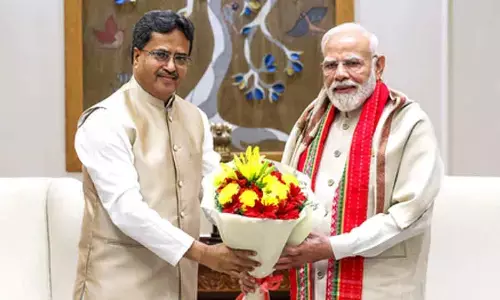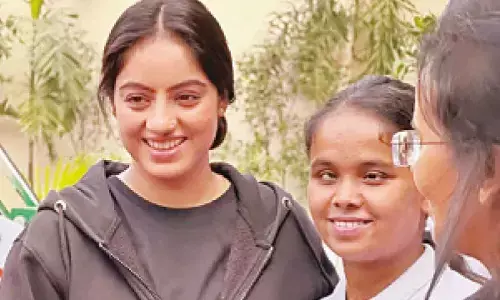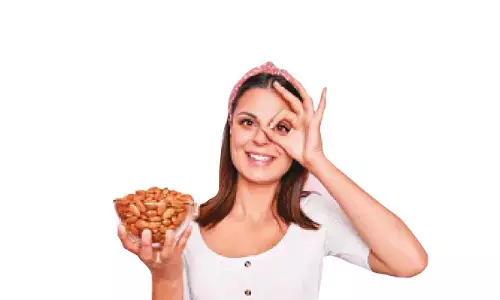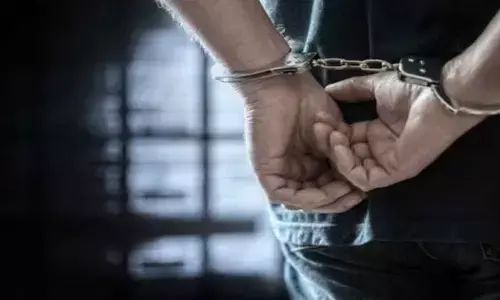Cheriyal Scroll Paintings: Languishing handcraft of Telangana
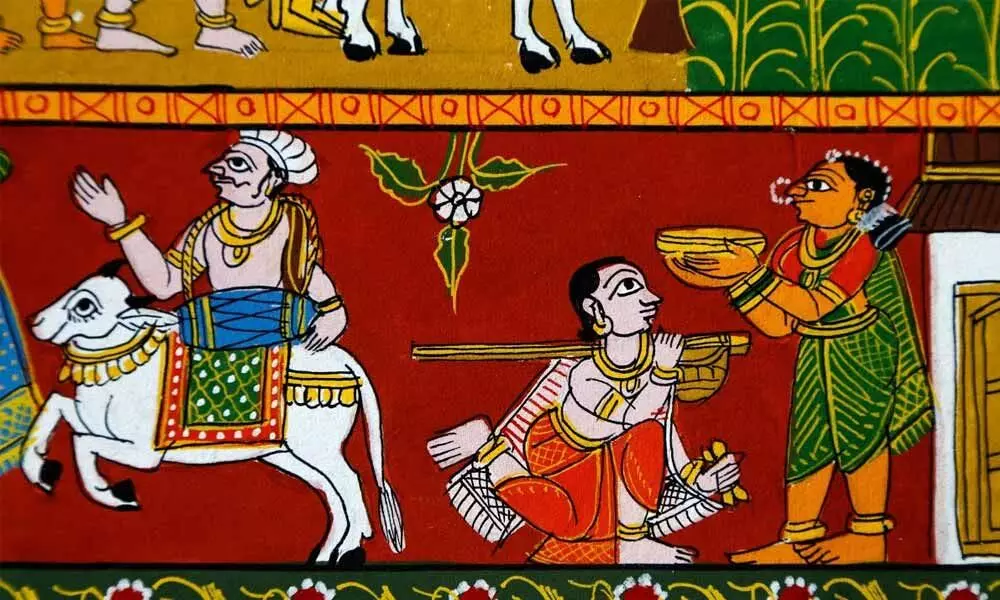 Cheriyal Scroll Painting
Cheriyal Scroll PaintingWith barely a few artists, numbering 18 belonging to six families, now practicing the craft of painting on cloth, traditionally known as ‘Scroll Paintings of Cheriyal’, the age-old art of telling a story literally and figuratively, in typical folk style is almost a languishing handicraft of Telangana
With barely a few artists, numbering 18 belonging to six families, now practicing the craft of painting on cloth, traditionally known as 'Scroll Paintings of Cheriyal', the age-old art of telling a story literally and figuratively, in typical folk style is almost a languishing handicraft of Telangana. The full credit for preserving the craft should go to Dhanalakota Vaikuntam Nakash, his two sons Rakesh and Vinay Kumar and his three cousins Nageshwar, Venkatramana and Pavan Kumar.
These few surviving descendants of folk artists are tirelessly engaged in the making of a number of scroll paintings at Cheriyal irrespective of market or no market. They, besides painting scrolls in powder colours on handloom cloth also make wooden figures using "Puniki Wood" which is light in weight and also used for making Kondapalli, Nirmal and Etikoppaka toys. The traditional scroll paintings are used as visual aids for the story telling traditions.
Cheriyal is a village near Jangaon, a little away from Hyderabad-Warangal highway, in Telangana, where the art of painting on cloth is kept alive in its true and traditional form by a few families. Unlike several traditional handicrafts of Telangana, or for that matter of India, this art form is not yet adulterated either in its designs or colour schemes and combinations despite their shifting from Cheriyal. Rajasthan has a rich tradition of folk paintings. Part of this heritage is the "Phada" a large painting on cloth, which commemorates the deeds of a hero from Rajasthan's colourful past. The smaller version of this type is known as "Phadakye". The stories of Phadas or Phadakye are chanted by the members of the "Bhopa" caste and are painted by members of the "Chippa" Caste called Joshis in Rajasthan.
The scroll paintings of Cheriyal were used by the village bards describing verses from the epics and other Puranas. Describing them as one of the best examples of audio visual aids, it is said that scrolls running into several metres were unrolled before a rapt audience under the banyan tree in the temple compound or even in the village square while the bard narrated, taking them into the pages of the story as the scroll unfolded its images to them.
The scroll paintings depict both religious and secular themes and were used in the past to educate and entertain people. Telangana Scrolls narrate the origin of a particular caste and eulogise the daring exploits of their legendary hero.
Traditional painting has always had something to do with religion. The great tradition of mythology and epics were conveyed in visual form through traditional painting. It was a collective expression, a pictorial conception of the total body of myth, ritual, magic and religion bequeathed by one generation to the next in a given social structure.
The scroll painters cater to the needs of story tellers who tour the village and countryside and entertain villagers showing visual images that are often set to music. Their experience has been that, they have known washer men, toddy tappers and weaves in Telangana commissioning Nakashis to paint their own favourite themes and stories pertaining to their local and ethnic gods and goddesses.
Jadupata Paintings of Bihar, Phad Paintings of Rajasthan, the illustrated scrolls of the Garoda in Gujarat and Pata paintings of Orissa are some of the traditional paintings of our country besides scroll paintings of Cheriyal. Kalamkari paintings of Andhra Pradesh, the Tanjavore Paintings, Chitrakathi paintings of Maharashtra, Nathdwara paintings of Rajasthan, Kalighat paintings of West Bengal, Gold Leaf paintings of Karnataka and Madras deserve to be mentioned. There are many more like Madhubani Paintings of Bihar and Kangra style painting of Himachal Pradesh.
The folk artists of scroll paintings of Cheriyal belong to Nakashis - meaning one who makes pictures-a community that might have migrated from Rajasthan about a couple of hundred years ago. The scrolls are usually vertical and may sometimes be 40 to 50 feet long. The work begins with preparation of cloth. Cora cloth, which is normally bought either in the nearby local market or from Warangal is used. The cloth is treated with a paste of rice-starch, Tiruman Gum, white clay (Sudda) and water. Lime is also used to soften it. After the treatment with the paste of above mixture the cloth is dried in the sun.
The theme of the painting is drawn on the dry cloth with Jaju powder solution. The background is filled with red colour. The figure, their attire and ornaments are given different colours. The frequently used colours are green, blue, yellow, maroon etc. Black is used for the outline. Black dye is made by mixing soot from kerosene lamp with groundnut oil. Hair from the goat's tail is used to make bristle of the brushes which are used to paint broad outlines and filling in work. Normally the women, wives of the artists do the outlines and other minor work. Though, earlier, colours were prepared from vegetable dyes, these days cakes of mineral and chemical colours are mixed with gum from Tiruman tree. The scrolls come alive with the vibrant figures that emerge.The themes of the scroll paintings are usually episodes from the Mahabharata and other folklores. The oldest theme is the Markandeya Puranam which is 500 years old. Others are Madelu Puranam, Arjun Tapas, Arjun and Shiva with Parvati, Krishna, Radha and Gopika, Virataparvam, Daksha Yagnam, Parvati Kalyanam etc.
The communities of story tellers are categorised based on the themes they expose such as Ramayana as Arthapodu, Mahabharata as Kakipodika, Goudapuranam as Gowdachetty, Madelu Puranam as Chakalipata Naidu, Markandeya Puranam as Konapuli, Jambavanta story as Dokkota and Daksha Yagnam as Guruppa. The earliest surviving scroll depicting the legend of Markandeya and Bhavanrishi dates back to 1625 and carries the date November in the year 1644 as the date of transfer of ownership. No other paintings of Indian scrolls have existed for so many years. The Cheriyal scroll paintings are ideal wall hangings, some of them several meters long.
The art of scroll paintings was also practiced in Anupuram, a small village in Karimnagar district though only on a very small scale. Unfortunately, the artists of this area could not withstand the influence of calendar styles. There has been little folk or tradition in their rendering.
The rural based source of entertainment is sustained by the people's belief that they attain Punya and go to heaven after death by listening to the stories from the epics. These programmes are arranged from January to April which is a lean season for farmers. However, the patronage is dwindling.
Unfortunately, for various reasons including the desire to educate their children and also to seek alternate mode of making adequate earnings, all the artists have shifted from Cheriyal to Hyderabad's Boduppal carrying the family tradition of making the handicraft with them. Thus, the Cheriyal Scroll Paintings have now become Hyderabad Boduppal Scroll Paintings! Nevertheless, the craft is saved from totally languishing thanks to the family members' enthusiasm to keep it alive.
(The writer is formerly Senior Manager, Handicrafts Development Corporation)



